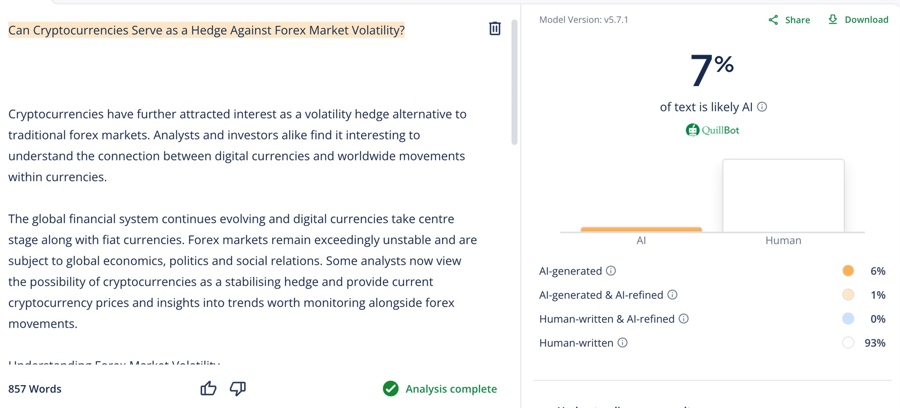Cryptocurrencies have further attracted interest as a volatility hedge alternative to traditional forex markets. Analysts and investors alike find it interesting to understand the connection between digital currencies and worldwide movements within currencies.
The global financial system continues evolving and digital currencies take centre stage along with fiat currencies. Forex markets remain exceedingly unstable and are subject to global economics, politics and social relations. Some analysts now view the possibility of cryptocurrencies as a stabilising hedge and provide current cryptocurrency prices and insights into trends worth monitoring alongside forex movements.
Understanding Forex Market Volatility
Forex markets are naturally reactive to shifts in the economy's direction, geopolitics and global trade flows. Spontaneous moves by the central bank, changes in interest rates, or political instability can cause sudden jumps or drops in pairs such as the euro-dollar or yen-dollar. Volatility can affect global trade, investment decisions and corporate treasuries.
In such a situation, investors look for securities, whose correlation is minimal compared to fiat currencies, for purposes of diversifying the exposure. Cryptocurrencies, as decentralized currencies, represent a new asset class whose behavior is quite different from traditional currencies. Their immaterial nature and global utilization adds both opportunities and risks for the portfolio analysis field.
Traditional vs. Digital Assets
A hedge is typically an investment used to reduce risk from negative market movement. Previously, commodities like gold or government securities were used for this purpose. Digital currencies and cryptocurrencies in particular, provide an alternative means. They are not tied into any single national economy. Therefore, they potentially more resistant to regional economic shocks.
Unlike traditional hedges, cryptocurrencies run 24/7 across worldwide networks, ensuring continuous liquidity. Analysts contend that this nonstop trading environment, combined with decentralized protocols, creates distinct challenges when evaluating risk mitigation strategies in forex markets.
Cryptocurrencies as a Hedge
The concept of cryptocurrencies serving as a hedge against forex volatility relies on their independence from central banks. For example, Bitcoin has a fixed supply and operates independently of traditional monetary policies. According to data from crypto exchange Binance, Bitcoin has recently changed hands for around $115,615 and Ethereum for around $4,400, exhibiting the high market value and liquidity of leading digital currencies.
Fiat-pegged stablecoins, on the other hand, offer a contrasting purpose. They do not have vast developmental potential, but can be utilized as a short - term protection for volatility through the retention of value when markets change abruptly. The two - fold agenda allows the coins to perform various tasks within overall investment portfolios, not necessarily working always as classical hedges. Their behavior for the currency volatility allows the experts to realize how the digital currencies are defining the role that the former are taking within the international financial system.
Looking at Correlation Analysis
Research indicates that there is generally a low to moderate correlation between major cryptocurrencies and forex pairs. Since both markets are prone to volatility, the prices of Bitcoin or Ethereum are not always indicative of movement within the classical fiat currencies.
Nils Andersen-Röed, Global FIU Head, underscores the necessity for the monitoring of digital payments: "Despite advanced privacy tools, every crypto transaction leaves a trace – a crucial asset for modern law enforcement. As crypto crime grows more complex, global cooperation and strong public-private partnerships are not optional, but essential." This trackability means that even though cryptocurrencies are decentralized, their flows can still be analyzed for market information and security issues, an ever-relevant consideration among institutional observers.
Practical Trading Strategies
Understanding how cryptocurrencies interact with forex markets can teach broader analytical perspectives. Most analysts observe trends, correlations and liquidity gauges for market direction without making speculative recommendations.
Data from crypto exchange platform Binance depict Bitcoin’s 24-hour trade volume having varied over the recent past within the $27 billion mark, a sign of global investors’ high interest. Ethereum’s volume also depicts sound liquidity, with the volume for the day hitting $15 billion plus. These figures depict the depth of the market and the capacity of digital currencies to break beyond classical fiat cycles. Following such trends provides an extra layer of analysis within the financial arena.
Investors watching for these trends can explore the behavior of digital currencies during times of devaluation of a currency or matters of geopolitical uncertainty, determining if the cryptocurrencies serve as a store of value alternative, not a hedge directly. Continued development of decentralized finance and institutional interest adds to the worldwide financial focus on the topic.
In The End
Cryptocurrencies are increasingly emerging as a potentially stabilising entity for the forex market volatility, though they don't replace the traditional hedging tools per se. Their decentralized mechanism, global accessibility and liquidity evoke special parameters that mark them apart from the mainstream currencies. Under constant surveillance and further global cooperation for law enforcement, digital currencies increasingly enter the financial system responsibly.
As cryptocurrency prices and market activity fluctuate, analysts can better understand their relationship with traditional currency markets. This adds an additional variable for assessing the overall stability of the financial system in an increasingly fast-moving world. Continuous monitoring is essential to track the evolving role of digital currencies within global finance.




